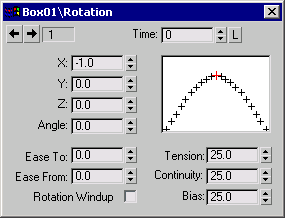 Command entry:Main toolbar
Command entry:Main toolbar 
 (Curve Editor (Open))
(Curve Editor (Open))  Select a track in the Track View hierarchy.
Select a track in the Track View hierarchy.  Track View menu bar
Track View menu bar  Controller menu
Controller menu  Assign
Assign  TCB
TCB
TCB Controllers produce curve-based animation much like Bezier controllers. However, TCB controllers do not use tangent types or adjustable tangent handles. They use fields to adjust the Tension, Continuity, and Bias of the animation.

This controller works well as a Position controller in conjunction with the Motion panel  Trajectories display of an object. With sub-object keys turned on and the Key Info dialog for a key displayed (right-click
and select Key Info on the selected key to display Key Info properties), you can change the parameters in the Key Info dialog
and see the trajectory path change. This allows for very precise control of an object's trajectory with visual feedback.
Trajectories display of an object. With sub-object keys turned on and the Key Info dialog for a key displayed (right-click
and select Key Info on the selected key to display Key Info properties), you can change the parameters in the Key Info dialog
and see the trajectory path change. This allows for very precise control of an object's trajectory with visual feedback.

Euler XYZ is now the default rotation controller in 3ds Max. The TCB Rotation controller was the default rotation controller for files created in versions 4 and earlier.
To change an Euler XYZ Rotation controller into a TCB Rotation controller:
 Select an object animated with an Euler XYZ rotation controller.
Select an object animated with an Euler XYZ rotation controller.
 I Motion panel
I Motion panel  Parameters
Parameters  Assign Controller rollout, select the Rotation track in the list window.
Assign Controller rollout, select the Rotation track in the list window.
 (Assign Controller), and then select Quaternion (TCB).
(Assign Controller), and then select Quaternion (TCB).
You can also assign this controller in Track View or from the Animation menu.

TCB controllers display their properties in a Key Info dialog in Track View and a single Key Info rollout in the Motion panel.
Charts the effect that changing the controller properties will have on the animation. The red mark at the top of the curve represents the key. The marks to the left and right of the curve represent an even division of time to either side of the key.
The TCB graph is a stylized representation of the animation around a single key. If you want to view the effect of changing TCB properties on the true animation curve, use the Function Curves mode of Track View (works only with position and scale).
The following descriptions refer to both the TCB graph and the function curve as the animation curve.
Controls the amount of curvature in the animation curve.
High Tension produces a linear curve. It also has a slight Ease To and Ease From effect.
Low Tension produces a very wide, rounded, curve. It also has a slight negative Ease To and Ease From effect.
The default value of 25 produces an even amount of curvature through the key.
Controls the tangential property of the curve at the key. The default setting is the only value that produces a smooth animation curve through the key. All other values produce a discontinuity in the animation curve causing an abrupt change in the animation. Default=25.
High Continuity values create curved overshoot on both sides of the key.
Low Continuity values create a linear animation curve. Low continuity creates a linear curve similar to high tension except without the Ease To and Ease From side effect.
The default setting creates a smooth continuous curve at the key.
Controls where the animation curve occurs with respect to the key. Default=25.
High Bias pushes the curve beyond the key. This produces a linear curve coming into the key and an exaggerated curve leaving the key.
Low Bias pulls the curve before the key. This produces an exaggerated curve coming into the key and a linear curve leaving the key.
The default setting distributes the curve evenly to both sides of the key.